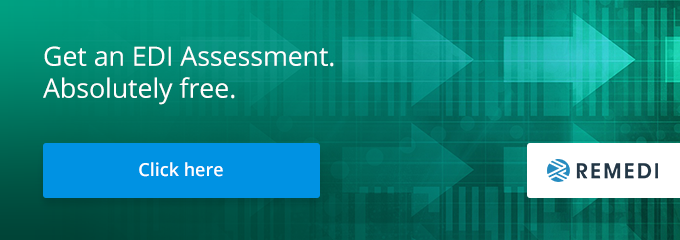
Electronic Data Interchange (EDI) has been around for more than 60 years. It has faced numerous shake-ups and undergone several notable changes, but it has persevered as the widely accepted standard for multi-enterprise integration.
Recently, however, EDI has been increasingly challenged by new-age technologies and evolving business needs. Meanwhile, APIs have given rise to end-user integration platforms that facilitate multi-enterprise interactions seemingly more directly than traditional EDI models.
Most players in the business world still believe integrating EDI is critical for B2B transactions and will remain for years to come. But, on the other hand, they also acknowledge that innovation is necessary to ensure enterprises that rely on EDI also benefit from emerging solutions.
In today's post, we dive deep into the changing face of EDI in the wake of technological disruptions, shedding light on how EDI is evolving around newer technologies like the cloud, IoT, AI, and analytics. We also discuss how APIs are presumably challenging EDI and elaborate our take on how things will play out down the road.
Emerging Technologies are Transforming EDI
Although EDI is mature and well-established, enterprises across numerous industries invest heavily in new technologies that offer financial improvements and competitive advantages. In particular, cloud computing, the internet of things, artificial intelligence, and advanced data analytics are taking over the business scene, severely disrupting traditional B2B integration approaches.
Fortunately, EDI platform developers, providers, and consultants are responding accordingly to deploy EDI upgrades and offer EDI integration consulting alongside these technologies.
Read on to uncover how EDI is evolving to align itself with advancements in cloud computing, IoT, AI, and analytics.
Cloud: EDI-as-a-Service
Cloud computing is increasingly taking over enterprise processes. The cost, security, stability, and scalability benefits it offers have made migrating to the cloud a "no-brainer" in the business world. According to IDC research, 90% of all global enterprises will be using a multi-cloud platform by 2022.
EDI has made a commendable effort in aligning itself to the cloud revolution. The integration of cloud-based tools with EDI has given rise to EDI-as-a-service, harnessing conventional SaaS models to deliver simplified, intuitive, and flexible solutions. As a result, EDI has become more accessible for partners, notably smaller enterprises that lack in-house EDI deployment skills.
Below are three remarkable benefits of EDI-as-a-service.
- Efficiency. EDI automates communication and management processes, creating efficient workflows that reduce operational costs.
- Visibility and control. Cloud-based tools provide real-time accessibility, giving partners complete visibility over the supply chain, and enabling them to make decisions based on accurate, updated information.
- Fast and easy deployment. With EDI-as-a-service, businesses can avoid the challenges of on-premises EDI implementation, rollout, and management and instead focus on maximizing the opportunities of seamless cross-enterprise integration.
As enterprises continue to embrace multi-cloud and hybrid-cloud strategies, the relationship between EDI and the cloud will become even more significant.
IoT: Instantaneous EDI
The internet of things has made remarkable progress since its early RFID days. Statista estimates the number of interconnected devices to be 21.5 billion today, up from 10 billion in 2016. These gadgets are set to multiply even further over the next several years, as internet consumption rises and more use cases hit the market.
At their core, IoT devices enable real-time monitoring and data collection. When deployed in supply chains, they can facilitate monitoring at virtually all levels, measuring conditions like temperature, humidity, and speed and events like a missed delivery or dropped parcel.
EDI experts generally consider IoT a potentially invaluable tool in B2B integration. While IoT does not influence EDI standards and their usage, it can facilitate instantaneous data exchange by giving partners direct access to centralized data hubs fed by IoT devices. Utilizing IoT, EDI data can be updated instantly and securely while giving trading partners greater end-to-end visibility.
AI: Intelligent EDI
The advent of artificial intelligence has had profound impacts on enterprises. Organizations have gained significantly by automating manual processes and redirecting resources from mundane tasks to critical units like product development and marketing.
AI's unending automation potential makes it significantly beneficial to current EDI models. Although EDI itself streamlines B2B integration and eliminates the need for time-intensive, error-prone manual processes, all traditional EDI systems require frequent monitoring and maintenance to sustain maximum efficiency. AI-enabled EDI platforms can spot trends and activate flags when patterns are interrupted, ensuring integration errors are caught and resolved efficiently.
AI can also ensure accuracy when converting non-EDI documents into specific EDI formats. For example, an AI-capable EDI solution can recognize exchange patterns and standard document fields like account numbers and price per line item, convert them into an EDI format, and accurately line up data to retain the structure on the original document. As a result, costly errors can be avoided, and partners can benefit from consistently formatted documentation, regardless of the origin of data.
Analytics: Insightful EDI
EDI is a major source of business data. Depending on the transaction, EDI data can cover every aspect of the supply chain, from initial purchase order to final payment, with status updates along the way. With analytics, partners can unlock numerous opportunities to learn about the ever-changing supply chain and make accurate predictions for future growth and risk factors.
Currently, EDI solutions are incorporating various analytical tools to help customers make the best use of their data. One of the primary areas addressed by analytics is "on-time in-full" performance. By analyzing the aggregated data, a business can gauge its performance with trading orders and identify patterns that could point out challenges relating to particular vendors, customers, locations, distributors, or products.
Merging analytics with EDI also makes it easier for businesses to understand sales cycles and better align resource allocation with demand in today's increasingly competitive market. The integration of comparative planning, forecasting, and replenishment (CPFR) can go a long way to maximizing profits and minimizing risks.
EDI in the future: Will API and Blockchain take over B2B integration?
The roles of API and blockchain in enterprise connectivity have expanded rapidly in recent years, so much so that industry players are wondering if one or both technologies will replace EDI as the dominant enabler of B2B integration.
This section addresses the significance of API and blockchain in today's supply chains and how both will likely influence EDI in the future.
EDI vs. API
APIs are widely regarded as the biggest disruption to traditional EDI. Although few experts predict an imminent migration from EDI to APIs, some foresee APIs will replace EDI at least partly within a few years. Gartner reports that API could facilitate more than half of all B2B transactions in 2023.
Application Programming Interfaces are collections of rules and protocols that specify how different components of applications or systems connect and interact. For example, with an API, developers can create channels that enable real-time system connectivity and data access across teams. That way, a team member does not always have to request another member for information.
On paper, APIs deliver value by allowing direct, real-time data access from trading partners, which translates to rapid-fast system integration. However, the prospect of APIs replacing EDI is short-sighted. In many ways, API is currently in the same position XML was at the turn of the millennium.
In his 2001 article titled- XML - The Future of EDI?, Uche Ogbuji argued that newer XML formats were easier to read than traditional EDI formats. This logic can also be presented in support of API usage over EDI. Still, as with XML, it overlooks the fact that EDI messages are not designed to be human-readable but rather to facilitate effective machine-to-machine data exchange with minimal human interaction.
Another prevalent argument supporting APIs is they enable the design of tailored processes. However, while bespoke solutions are potentially beneficial on a small scale, they become increasingly impractical in more extensive supply chains where disparate players interact to deliver the final product. In such environments, standardization is critical for seamless integration.
Below are some standardization shortcomings of APIs that make them unsuitable for large-scale multi-enterprise integration.
- Design rules, protocols, and underlying processes are not standardized. Partners are free to design and deploy tailored platforms.
- Unlike classic EDI standards, such as ANSI X12 and EDIFACT, API data semantics do not follow globally accepted semantics.
- API documentation is not standardized for community-wide business analysts and developers.
Despite these deficiencies, API is not necessarily inferior to EDI. More accurately, APIs are better suited for different scenarios than EDI. API integration is ideal for direct system integrations, such as connecting a CRM to an ERP or when all partners must use a single access platform due to legal requirements. On the other hand, EDI is better suited for multi-enterprise integration, where standardization is essential.
According to a Project 44 survey, 63% of supply chain executives believe API will play an essential role in future B2B interactions, but only 5% believe EDI will become less significant. These results support the prominent belief that both technologies will more likely coexist than collide, with API facilitating system-to-system integration and EDI enabling seamless cross-partner interaction.
EDI vs. Blockchain
From its origins as a cryptocurrency platform, blockchain has exploded in recent years. Today, numerous industries are implementing blockchain-based solutions for storing and sharing all sorts of digital data. Therefore, it is not surprising that several reports, including one from TechCrunch, are calling it the next step in enterprise integration.
Blockchain is a ledger-based database that continuously records changes within its data in structures called blocks. Data blocks are linked chronologically, and any new transaction creates a new block that is added to the end of the chain. Once created, information in blocks can be accessed by all partners with the ledger, but it cannot be altered.
Blockchain has several benefits that make it appealing for enterprise data exchange. Some of these include:
- Immutability, which ensures data accuracy and trust
- Distributed nature, which promotes visibility among players.
- Continuous transaction updates, which facilitate provenance in supply chains.
Many experts believe blockchain ledgers will become more popular down the road as companies increasingly prioritize collaboration over point-to-point communication. According to ByteAlly Software CEO Karthikeyan Mani, blockchain could take precedence over EDI by "completely removing the need for partners to exchange files."
However, one hindrance to blockchain's adoption as an EDI alternative is its complexity in multi-enterprise B2B integrations. To participate in blockchain transactions, all partners must agree to use the same type of blockchain and share not only formats and protocols but end-to-end business processes.
Even if businesses agree to a unified blockchain, EDI will still have a role to play because of its already established universal standards. So, instead of a complete replacement of EDI with blockchain protocols, EDI exchange models will more likely evolve to enable businesses to benefit from blockchain. EDI standards may even start syncing with blockchain networks to create a fluid working relationship, where EDI-formatted data is stored in the blockchain to create a single source of truth.
As IBM notes, the true future of EDI lies in "evolving EDI alongside disruptive technologies like blockchain to deliver innovative levels of multi-party supply chain collaboration."

Despite being in use for a long time, EDI has remained dominant for a good reason. Anyone who has used EDI standards closely will appreciate the effort that has gone into defining, deploying, and maintaining them over the years.
However, the benefits that new technologies like the cloud, IoT, AI, advanced data analytics, API, and blockchain bring to the table are undeniable. Every business is looking to leverage these innovative solutions for improvements. As a result, legacy EDI toolkits can no longer deliver the entire B2B process with the efficiency required to remain competitive in the market.
EDI solutions must extend capabilities beyond traditional models and become modernized platforms that facilitate end-to-end integration, any-to-any connectivity, real-time response, on-demand visibility, and other critical requirements of today's business world. By evolving in tandem with emerging solutions, EDI can become more flexible, scalable, complete, and future-ready.
Remedi is a global leader in B2B integration resources. Over the years, we have helped numerous businesses achieve their EDI upgrade goals through tailored modernized solutions.
Contact us today, and learn how you can get the most out of EDI.



